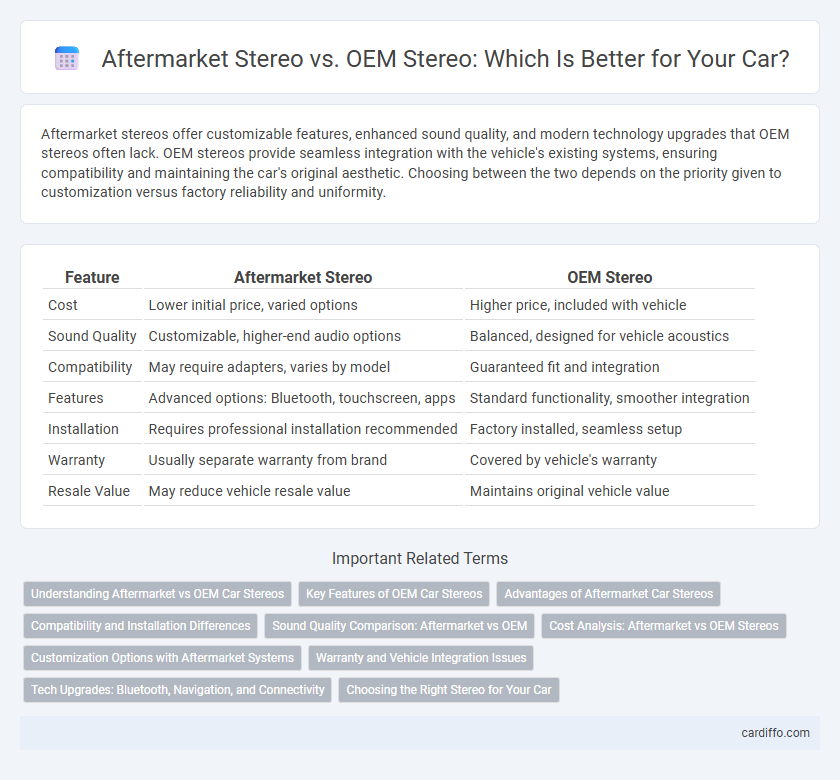Aftermarket stereos offer customizable features, enhanced sound quality, and modern technology upgrades that OEM stereos often lack. OEM stereos provide seamless integration with the vehicle's existing systems, ensuring compatibility and maintaining the car's original aesthetic. Choosing between the two depends on the priority given to customization versus factory reliability and uniformity.
Table of Comparison
| Feature | Aftermarket Stereo | OEM Stereo |
|---|---|---|
| Cost | Lower initial price, varied options | Higher price, included with vehicle |
| Sound Quality | Customizable, higher-end audio options | Balanced, designed for vehicle acoustics |
| Compatibility | May require adapters, varies by model | Guaranteed fit and integration |
| Features | Advanced options: Bluetooth, touchscreen, apps | Standard functionality, smoother integration |
| Installation | Requires professional installation recommended | Factory installed, seamless setup |
| Warranty | Usually separate warranty from brand | Covered by vehicle's warranty |
| Resale Value | May reduce vehicle resale value | Maintains original vehicle value |
Understanding Aftermarket vs OEM Car Stereos
Aftermarket car stereos offer enhanced customization, advanced features, and updated technology compared to OEM stereos, which are designed for factory specifications and seamless integration. Choosing between aftermarket and OEM stereos depends on the balance between desired audio performance, ease of installation, and maintaining vehicle warranty. Understanding these differences helps in selecting a stereo system that best matches driving preferences and audio quality requirements.
Key Features of OEM Car Stereos
OEM car stereos provide seamless integration with a vehicle's existing electrical system and dashboard design, ensuring a factory-standard look and simplified operation. They typically feature manufacturer-specific tuning that optimizes sound quality for the car's acoustics and incorporate built-in safety and convenience functions like steering wheel controls and compatibility with onboard diagnostic systems. High durability and warranty coverage aligned with the vehicle further distinguish OEM stereos from aftermarket options.
Advantages of Aftermarket Car Stereos
Aftermarket car stereos offer superior audio quality and advanced features like touchscreen displays, smartphone integration, and customizable sound settings compared to OEM stereos. They provide greater flexibility in upgrading and personalizing car audio systems to fit individual preferences. Enhanced connectivity options and expanded compatibility with modern devices make aftermarket stereos a popular choice for car enthusiasts seeking optimal in-car entertainment.
Compatibility and Installation Differences
Aftermarket stereos offer greater compatibility with a wide range of vehicles through universal wiring harnesses and mounting kits, whereas OEM stereos are specifically designed for a vehicle's factory setup, ensuring seamless integration. Installation of OEM stereos is typically straightforward with plug-and-play connectors, while aftermarket installations often require additional adapters, modifications, or professional expertise. Choosing between aftermarket and OEM stereos depends on balancing customization options against ease of installation and guaranteed compatibility.
Sound Quality Comparison: Aftermarket vs OEM
Aftermarket stereos typically offer superior sound quality compared to OEM stereos due to advanced audio processing technology, higher power output, and customizable equalizer settings. OEM stereos often prioritize cost-efficiency and integration with vehicle systems, resulting in more limited sound performance and fewer tuning options. Audiophiles prefer aftermarket systems for richer bass, clearer highs, and overall enhanced acoustic experience tailored to individual preferences.
Cost Analysis: Aftermarket vs OEM Stereos
Aftermarket stereos generally offer a lower upfront cost compared to OEM stereos, making them an attractive option for budget-conscious consumers. While OEM stereos often include integrated features tailored for specific vehicle models, aftermarket options provide versatile customization at a reduced price point. Long-term costs may vary, as aftermarket systems can require additional installation fees and potential compatibility adjustments, whereas OEM stereos are designed for seamless integration with existing vehicle electronics.
Customization Options with Aftermarket Systems
Aftermarket stereo systems offer extensive customization options, including enhanced audio processing, touchscreen displays, and smartphone integration, which are often limited or unavailable in OEM stereos. These systems allow users to choose components tailored to their audio preferences, such as amplifiers, equalizers, and speakers, delivering a personalized sound experience. OEM stereos prioritize standard features and integration with the vehicle's design but lack the flexibility for advanced upgrades and personalization found in aftermarket setups.
Warranty and Vehicle Integration Issues
Aftermarket stereos often come with limited or separate warranties that do not cover the entire vehicle, potentially voiding the factory warranty if installation is improper. OEM stereos provide seamless vehicle integration, ensuring compatibility with the car's existing systems such as steering wheel controls, backup cameras, and navigation. Choosing OEM ensures warranty protection and optimal functionality, while aftermarket options may introduce integration challenges and affect warranty coverage.
Tech Upgrades: Bluetooth, Navigation, and Connectivity
Aftermarket stereos offer advanced tech upgrades such as Bluetooth for wireless audio streaming, integrated navigation systems with real-time traffic updates, and enhanced connectivity options including smartphone integration via Apple CarPlay and Android Auto. OEM stereos often provide seamless compatibility with the vehicle's existing electronics but may lack the latest features found in aftermarket models. Choosing an aftermarket stereo enhances in-car entertainment and convenience by delivering cutting-edge technology that complies with modern digital lifestyles.
Choosing the Right Stereo for Your Car
Choosing the right stereo for your car involves evaluating aftermarket stereos, which offer advanced features like Bluetooth connectivity, touchscreen interfaces, and enhanced audio quality, versus OEM stereos that ensure seamless integration and maintain factory aesthetics. Aftermarket options provide customization and upgraded performance tailored to personal preferences, while OEM stereos guarantee compatibility with your car's existing systems and retain original warranty coverage. Consider your priorities for sound quality, technology, installation ease, and vehicle compatibility to make the best choice between these two stereo types.
Aftermarket stereo vs OEM stereo Infographic

 cardiffo.com
cardiffo.com